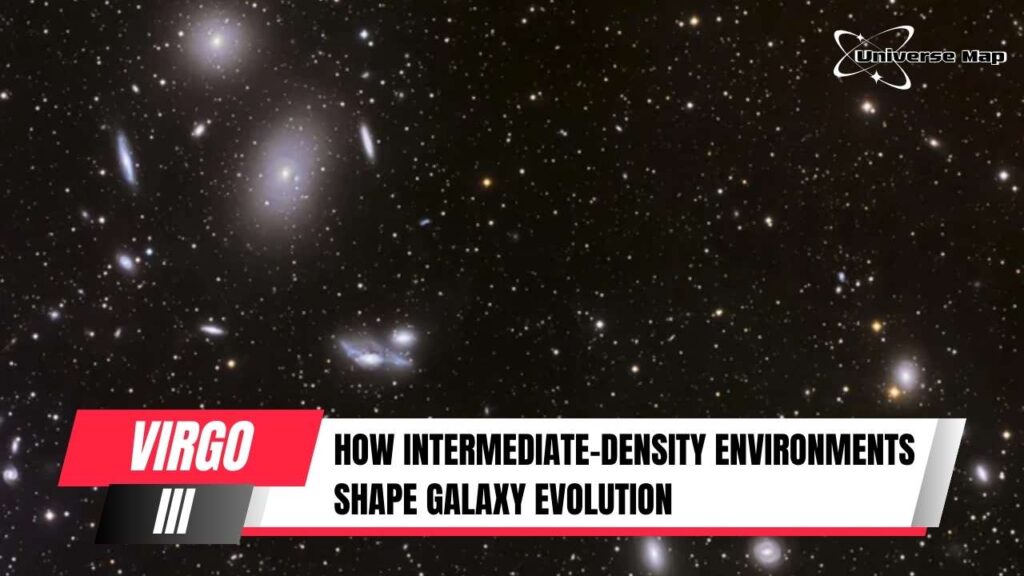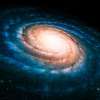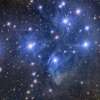
Introduction: Between the Void and the Cluster Core
Galaxies do not evolve in isolation. Nor do they always reside in dense, turbulent clusters like Virgo or Coma. Many galaxies exist in intermediate-density environments—galaxy groups—where interactions are frequent but less extreme, shaping their evolution in subtle yet powerful ways.
The Virgo III Groups represent one such region:
- A collection of loosely bound galaxy groups
- Located ~40–65 million light-years away in and around the Virgo constellation
- Featuring a rich mix of spiral, elliptical, lenticular, and dwarf galaxies
This environment offers a unique window into how mild gravitational interactions, tidal stripping, and environmental mechanisms can:
- Reshape galaxies over time
- Suppress or enhance star formation
- Transform spirals into lenticulars or ellipticals
What Are the Virgo III Groups?
The Virgo III Cloud is not a single cluster but a composite of subgroups, including:
| Subgroup | Notable Member(s) | Dominant Galaxy Types |
|---|---|---|
| NGC 4697 Group | NGC 4697 (Elliptical) | Ellipticals, lenticulars |
| NGC 5364 Group | NGC 5364, NGC 5363 | Spirals, lenticulars |
| NGC 5248 Group | NGC 5248 (Barred Spiral) | Star-forming spirals, dwarfs |
Unlike dense clusters where galaxies are tightly packed and rapidly merge, these subgroups are more loosely structured, making them ideal for observing natural evolution processes.
Why Intermediate Environments Matter
| Environment Type | Characteristics | Impact on Galaxies |
|---|---|---|
| Isolated | Minimal interaction | Slow, internal evolution |
| Cluster Core | High-speed interactions, mergers | Disruption, stripping, quenching |
| Group (Virgo III) | Moderate encounters, tidal influence | Balanced transformation, subtle changes |
The Virgo III Groups represent a bridge between these extremes. Galaxies here experience:
- Enough interaction to alter morphology
- But not so much that they’re fully disrupted
This balance is crucial for understanding natural morphological transitions, star formation regulation, and the early phases of quenching.
Common Processes in Group Environments
- Tidal Interactions: Stretching and warping galaxies like NGC 5364 due to nearby companions
- Bar Formation: Induced by gravitational nudges, as seen in NGC 5248
- Gas Redistribution: Slow stripping or internal funneling affecting star formation
- Star Formation Triggers and Suppression: Not sudden bursts or total shutdown—but regulated activity
These processes lead to:
- Barred spirals forming central starbursts
- Lenticulars evolving from spirals
- Ellipticals like NGC 4697 settling into dormancy after long evolutionary journeys
1. NGC 4697 – Quiet After the Storm
| Type | Elliptical (E6)
| Distance | ~38–40 million light-years
| Star Formation | None
| Dominant Feature | Ancient stellar population, no gas
NGC 4697 is the most passive of the three galaxies—an old, gas-poor elliptical with:
- A smooth, elongated shape
- A halo full of globular clusters
- Evidence of past dry mergers and slow gravitational evolution
Environmental Influence:
- Located in a quiet subgroup
- Likely formed through mergers in an intermediate-density setting
- Tidal interactions in its early past drained gas and halted star formation
- Its present-day stability is a testament to the cumulative effects of slow, layered evolution
2. NGC 5364 – The Spiraling Sculptor
| Type | Grand-Design Spiral (SA(rs)bc pec)
| Distance | ~55–65 million light-years
| Star Formation | Moderate, arm-driven
| Dominant Feature | Beautiful, defined spiral arms
NGC 5364 is a striking spiral galaxy with:
- Symmetrical spiral arms rich in star-forming regions
- Interaction with the lenticular galaxy NGC 5363
- Evidence of tidal stretching and subtle warping in its outer arms
Environmental Influence:
- Part of a moderately interacting group
- Gravitational pull from neighbors likely triggered:
- Bar-like inner structure
- Enhanced star formation in arms
- Arm asymmetry from tidal distortion
This makes NGC 5364 a living example of how spiral galaxies respond to mild environmental stress.
3. NGC 5248 – Barred and Bursting with Stars
| Type | Barred Spiral (SAB(rs)bc)
| Distance | ~45–55 million light-years
| Star Formation | Active, especially in bar and central region
| Dominant Feature | Bright bar + active star-forming spiral arms
NGC 5248 is a more dynamically complex galaxy, with:
- A strong central bar driving gas inward
- Bright H II regions in the spiral arms
- A mild AGN-like core, possibly fueled by environmental interactions
Environmental Influence:
- Its group shows clear gravitational interaction patterns
- The bar and enhanced core activity suggest gas redistribution
- Star formation appears sustained by environmental compression and inflow
It exemplifies how barred spiral structure, even without strong tidal encounters, can evolve under moderate pressure.
Key Takeaways: Three Galaxies, Three Evolutionary Stories
| Galaxy | Evolutionary Path |
|---|---|
| NGC 4697 | Dry mergers → gas depletion → elliptical dormancy |
| NGC 5364 | Mild interaction → spiral arm enhancement & asymmetry |
| NGC 5248 | Bar-driven gas inflow → active star formation + AGN hint |
These three cases demonstrate that even in the absence of violent collisions or dense cluster pressure, the Virgo III environment can reshape galaxies—over billions of years, through slow, coordinated forces.
1. Tidal Interactions: Gentle Pushes with Lasting Effects
In dense cluster cores, galaxies often experience high-velocity flybys or disruptive mergers. But in groups like Virgo III:
- Relative velocities are lower
- Interactions are longer and more sustained
- Gravitational influences cause gradual structural changes
In Virgo III:
- NGC 5364’s spiral asymmetry likely results from tidal interaction with NGC 5363
- NGC 5248’s bar formation and enhanced core activity may be interaction-triggered
- Even elliptical galaxies like NGC 4697 could be remnants of older, cumulative tidal processes
These interactions are more surgical than explosive, leading to slow restructuring of morphology and star formation.
2. Ram-Pressure Stripping: Mild but Measurable
In cluster environments, ram-pressure stripping can rapidly remove gas from a galaxy’s disk as it moves through hot intracluster medium.
In Virgo III’s lower-density intragroup medium:
- Stripping is less violent, but still present
- Effects are localized, affecting outer gas reservoirs first
- Over long timescales, this contributes to star formation decline
Observational Signs:
- Lenticular transformation in galaxies with faint, truncated gas disks
- Gradual fading of spiral arms
- Central star formation continuing while outer regions are quenched
Though subtler, these slow processes mimic cluster-like evolution over extended timelines.
3. Bar Formation and Internal Gas Inflow
In several Virgo III spirals (e.g., NGC 5248), we observe:
- Formation of bars and rings
- Enhanced central star formation
- Inflow of gas toward the galactic core, possibly triggering mild AGN activity
These features arise when:
- External gravitational influence destabilizes the disk
- Angular momentum is redistributed
- Gas migrates inward, compressing into star-forming regions
This is especially common in barred spirals evolving under mild interactions—a common occurrence in Virgo III.
4. Morphological Transformation: From Spirals to Lenticulars
Over time, group galaxies may transition from spiral to lenticular (S0) morphologies, through:
- Gas loss via stripping and inflow
- Star formation decline
- Retention of stellar disk but loss of active spiral arms
In Virgo III:
- NGC 5363 (companion to NGC 5364) is a lenticular galaxy—possibly a faded spiral
- Other dwarfs within the groups show signs of partial morphological evolution
These transformations are not violent mergers, but environmentally induced transitions—a hallmark of group-level evolutionary pressure.
5. Comparison with Cluster Core Mechanisms
| Mechanism | In Virgo III Groups | In Virgo Cluster Core |
|---|---|---|
| Tidal Interactions | Mild, long-term | Strong, high-speed |
| Ram-Pressure Stripping | Present, weak-to-moderate | Rapid, highly disruptive |
| Galaxy Mergers | Occasional, low-velocity | Frequent, high-velocity |
| Star Formation Impact | Gradual decline, internal inflow | Sharp suppression, full quenching |
| Morphological Change | Slow spiral-to-S0 transitions | Often abrupt or merger-driven |
Virgo III provides the perfect middle ground—where natural evolution happens slowly but persistently.
What This Tells Us
- Group environments like Virgo III show that environmental effects are not exclusive to clusters
- Even without extreme conditions, galaxies evolve under subtle but coordinated forces
- These galaxies offer ideal laboratories for understanding quiet transformation in the universe
1. A Natural Laboratory Between Isolation and Chaos
Virgo III is not too quiet like the Local Group, nor too violent like the Virgo Cluster core. Instead, it offers a moderate gravitational environment, making it ideal for:
- Observing tidal influence without disruption
- Tracking morphological transformation in slow motion
- Understanding how galaxies evolve when left to interact gently over time
This intermediate nature positions Virgo III as a crucial testing ground for galaxy evolution models outside the extremes.
2. Diversity in Galaxy Types = Diversity in Evolution
From passive ellipticals like NGC 4697, to active spirals like NGC 5248, and beautifully symmetric galaxies like NGC 5364, Virgo III shows:
- Multiple evolutionary states within one group
- Morphological transitions happening at different rates
- A snapshot of how environment dictates diversity
This teaches us:
- Galaxy evolution is not one-size-fits-all
- Environment influences pace, pathway, and end state
- Intermediate groups produce morphological mosaics, not monoliths
3. Subtle Forces, Strong Consequences
The processes in Virgo III may be subtle:
- Mild tidal interactions
- Slow gas loss
- Bar-driven gas inflows
But their cumulative effect over cosmic time leads to: - Suppressed star formation
- Central concentration of mass
- Gradual transitions from spirals to S0 to ellipticals
This reinforces the idea that long-term gravitational influence, not just violent events, drives galaxy transformation.
4. Virgo III’s Role in Galaxy Evolution Research
Virgo III helps refine answers to fundamental questions:
| Question | Virgo III Insight |
|---|---|
| How do spirals become lenticulars? | Through sustained, slow environmental processes |
| Is star formation always quenched violently? | No, gradual suppression occurs in groups |
| Are bars linked to environment? | Yes, bar formation correlates with group interactions |
| Can elliptical galaxies form without clusters? | Yes, via dry mergers in small groups like NGC 4697 |
5. The Future of Virgo III Research
As telescope technology advances:
- JWST will reveal hidden companions, dust, and embedded structures
- ELT-class telescopes will measure individual stellar motions and chemical gradients
- ALMA and radio surveys will trace gas content and flow in high resolution
- AI-based simulation modeling will recreate Virgo III’s formation history
This will allow astronomers to:
- Better understand mild interaction effects
- Precisely model halo dynamics and dark matter distribution
- Track galaxy transformation timescales under intermediate-density influence
Final Thoughts
Virgo III is a quiet yet complex region of the universe—an evolutionary middle ground where:
- Galaxies evolve gently but inevitably
- Transformation is shaped by cooperation, not collision
- And the story of cosmic structure unfolds in layers, not explosions
For observers, Virgo III is a field of diversity and elegance.
For researchers, it’s a template for understanding environment-driven evolution.
For UniverseMap.net, it is a bridge between isolation and interaction, filled with galaxies worth exploring, frame by frame, light by light.












